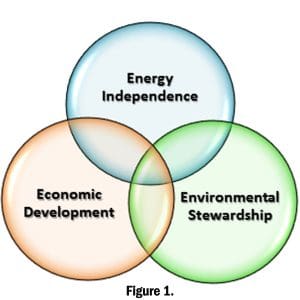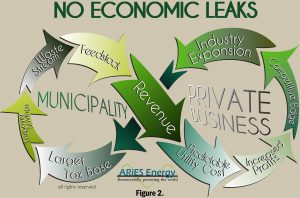Waste-to-Energy and the Three “E”s: Energy Independence, Economic Development and Environmental Stewardship
Public-Private partnerships turn waste streams into low-cost power.
Harvey Abouelata and Lauren Steier
Who would have thought that one of the final scenes from the 1980s movie Back to the Future showing a banana peel powering a DeLorean would be the basis for economic development, energy independence and environmental stewardship (the Three “E”s)? The reality of trash becoming treasure is upon us. According to SWANA, “Waste-to-energy is a reliable and renewable form of energy that has become the basis for many of the most successful solid waste management systems in the county.” Our landfills can be looked at as the refineries of the future.
The Three “E”s (Figure 1) are all fundamental for an autonomous sustainable community. Finding the balance between protecting the environment, creating economic development and establishing energy independence can be tricky. An excellent way of achieving this balance is by converting a community’s waste stream into energy. An innovative and highly efficient waste-to-energy technology called the CHyP System is a bioenergy technology that is engineered and manufactured by a U.S. company called Proton Power, Inc. CHyP is an acronym for Cellulose to Hydrogen Power. It is a gasification technology that uses processed waste or biomass as feedstock to create a syngas. This syngas is then used for combustion to generate power and/or heat for homes and buildings.
Where Waste Meets Energy
The U.S. is power hungry and our fuel is coming from finite sources, often outside of our nation. According to DOE’s Energy Information Administration’s Web site,1 we consumed 4,106 billion kilowatt hours in 2011, ranking us second in the world for energy consumption per capita. That’s enough power to operate a single 100-watt light bulb for 354 million years. The U.S. Environmental Protection Agency 2010 Municipal Solid Waste Facts and Figures2 reported that the average individual generates about 4.43 pounds of waste per day. The U.S. Department of Commerce, Census Bureau in 20103 reported an estimated 308.7 million people living in the U.S. These figures constitute about 175 million tons of usable trash annually for waste-to-energy conversion (subtracting approximately 30 percent for metals and other recyclable material).
Using the CHyP system, we have calculated that 6 percent of our nation’s energy needs could be provided just from the trash we are carting off to our landfills every day. According to DOE, in 2011, 13 percent of our nation’s energy came from renewables (including hydroelectric). So using our trash as a fuel source could increase that number by 50 percent.
The CHyP technology is very different and far more efficient than methane capture and incineration. With methane, there is still a need for landfills or anerobic digestion, both requiring a longer process to extract the energy. But with the CHyP System, waste is reduced upfront by diverting roughly 70 percent of what would go into a landfill and turning it into energy immediately, thereby greatly extending the life of the landfill. This process also avoids the emission of methane into the atmosphere from the landfill, which is a greenhouse gas 25 times more potent than carbon dioxide. The CHyP gasification technology differs from incineration in that more of the energy from the waste is retained in the syngas to be used to create electricity, instead of wasted in heat, producing more energy per ton than incineration. In a New York Times article by John Rathers entitled “Tapping Power from Trash”, he reports that the “8.1 million-ton Brookhaven Town landfill, which closed to garbage in 1996, has pumped 350,000 megawatt-hours of electricity into the power grid over the past 30 years” using methane. Using the CHyP system, 8.1 million tons of trash would be reduced by 30 percent for recycling and the remaining amount would produce 6,047,494 megawatt-hours of electricity, which is approximately 17 times more electricty.
After extensive review of the CHyP technology and vetting from many third-party entities, multiple benefits and solutions are possible for a variety of applications, depending upon your motivation:
Profitability and economic development
Energy independence and autonomy
Resource protection and environmental quality
Therefore, no “E” gets left behind.
Economic Development
Turning a waste stream into a useful commodity will drive economic development by turning a former liability into an asset. Also, using equipment that is engineered and manufactured in the U.S. strengthens our nation’s economy. Drastically extending the life of a landfill is a major advantage as we continue to encounter waste disposal issues such as operational costs, permitting and land requirements. According to a white paper from SWANA entitled Waste-to-Energy Facilities Provide Significant Economic Benefits, “monies spent on waste-to-energy technologies remain in the community, while 90 percent of monies spent on landfills will be transferred out of the local economy. Also, waste-to-energy facilities generate high paying jobs that cannot be outsourced.”
Energy Independence
The ability to produce power from a feedstock that comes entirely from the U.S. is a significant step towards national energy independence. To further this goal, we need to start at the community level. Currently, most people and businesses in a community are dependent on the utility grid for their energy and are subject to rate increases or power outages. But if communities have the ability to produce their own electricity from their own feedstock, they gain more control over the cost of their energy, thus creating an energy independent, autonomous community. This technology is one of the first affordable renewable technologies that is both on- demand and continuous, therefore allowing the option for one to be completely off the grid. Aside from using waste to generate electricity, the CHyP System can use any type of biomass, such as woody waste from brush collection, or energy crops such as switchgrass. So whether you are a business, municipality or community, this renewable energy can create true energy independence, which diminishes our nation’s dependency on finite fossil fuels and foreign sources of energy.
Environmental Stewardship
While turning waste into energy with the CHyP System helps create economic development and energy independence, it is also protecting the environment in several ways. First of all, by avoiding continuous use and creation of landfills, waste is considerably reduced and land is protected. Second, the emissions from this technology are significantly less than the emissions that would otherwise come from burning fossil fuels. And finally, our water resources are protected because these systems do not need a water source for cooling. The runoff from landfill operations into nearby waterways is also reduced or avoided. The environment, air, and water are all protected by this waste-to-energy system. According to the Energy Recovery Council:
“When a ton of trash is delivered to a waste-to-energy plant, several things happen: the energy content of the waste is retrieved, metals are recovered and recycled and electricity is generated. An EPA-sponsored lifecycle analysis evaluated a variety of waste management options and their associated environmental and energy impacts, and found that waste-to-energy does the most to reduce greenhouse gas releases into the atmosphere.”
Using the Brookhaven Town 8.1 million-ton landfill example, about 2.4 million tons would be recycled and the remaining solids to be disposed of after the gasification process would be approximately 227 thousand tons, which is a mere 3 percent of the original amount.
The Sustainable Community Model
Figure 2 illustrates a public-private partnership model showing how a waste-to-energy program can provide energy independence, economic development and environmental stewardship. It illustrates how to produce power, create jobs and protect our environment in order to create a truly sustainable community with no economic leaks.
Plan of Action
The first step is a commitment from the municipality to divert municipal solid waste (MSW) from the landfill and process it using one of the many technologies on the market today. Essentially, the MSW needs to be converted to a material that is of sawdust or dirt-like consistency to be used as feedstock for the CHyP System. Next, private industry would install CHyP Systems, and then enter a contract with the municipality to purchase the MSW feedstock. The sale of the feedstock becomes a revenue source for the municipality. The private industry can now produce low-cost electricity with a price controlled by the contract. Private industry becomes more competitive, allowing the industry to grow and become more profitable. The growth creates direct jobs which increases the tax base for the municipality. Growth also creates a larger waste stream, which will now be needed to produce more electricity that the private industry will need. This cycle is fundamental to sustainable growth.
To create thriving communities and attract new business, the legacy of economic growth and clean energy must start today. Public and private entities are in a good position to develop partnerships that will create viable and profitable solutions for alternative energy economics. Those who take control of their energy production will insulate themselves from the inevitable escalation of utility costs. Adopters of these innovative technologies will be the leaders of the future because they understand that waste-to-energy partnerships promote energy independence, increase economic and community growth, and protect the environment by providing responsible stewardship. With public-private partnerships, energy cost predictability becomes possible. Imagine the possibilities in your community.
Harvey Abouelata is President of ARiES Energy (Knoxville, TN) and Lauren Steier is the Market Research Analyst. ARiES Energy is a leading energy contractor that delivers turnkey, clean and renewable energy solutions. Harvey has over 18 years in developing business plan strategies and creative energy solutions that deliver the quickest ROI. He can be reached at (865) 309-4NRG, via email at [email protected] or visit www.ariesenergy.com.
Notes
www.eia.gov
www.epa.gov/epawaste/nonhaz/municipal/pubs/msw2008rpt.pdf
www.census.gov/prod/cen2010/briefs/c2010br-14.pdf
Sidebar
Fact
The U.S. population’s waste could create 24.5 gigawatts of capacity, capable of producing 236 billion kilowatt hours annually using efficient waste-to-energy technology.
Figure 1
Figure 2


